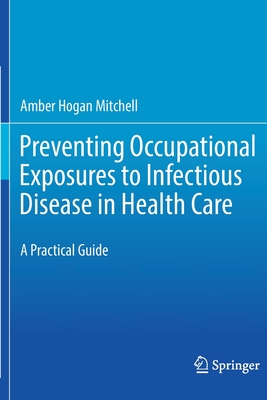You are here
Back to topPreventing Occupational Exposures to Infectious Disease in Health Care: A Practical Guide (Paperback)
$89.99
Usually Ships in 1-5 Days
Description
1. IntroductionThe introduction to the guide describes why it serves as a resource to be used by those with the greatest responsibility of all -- protecting one of our most valuable assets, healthcare personnel. Practical Guide users may include professionals with job functions or tasks in occupational or employee health and safety, infection prevention and control, biological safety, infectious disease, risk management, biological safety, and/or environmental health and safety in healthcare settings. The guide is meant to serve those with varying levels of experience in occupational health and/or occupational infection prevention. The introduction provides high-level information on how the guide serves as both background and fundamental information to help readers gain confidence as they ramp up in their roles. It highlights the tools, resources, and ideas that are new and ready to roll out or pass along.
2. Public Health SignificanceThis chapter discusses in detail why occupational exposure to infectious diseases in health care is an important public health issue. Since there are hundreds of microorganisms that can cause illness or infection in humans (pathogenic organisms), this chapter describes the highest prevalence organisms that affect healthcare workers. It provides a list and discussion for what microorganisms are most likely to cause occupational illness or infection in the working population. It also exposes the reader to provocative information about the healthcare environment, and vectors including contaminated hands, patient care items (e.g., blood pressure cuffs, stethoscopes), medical devices (e.g., IV infusion connectors, endoscopes, surgical instruments), and contaminated surfaces or textiles (e.g., uniforms, lab coats, sinks, toilets, bedrails, etc.).
3. Controlling & Preventing Occupational Illness & InfectionThe chapter sets the stage for a grounding in the critical elements in an occupational infection prevention and control plan. It describes important employee vaccination and immunization plans. The concepts of the industrial hygiene hierarchy of controls are introduced. The hierarchy is an evidence-based method to help readers build, design, and evaluate preventive strategies that provide the highest and most productive levels of protection. It also provides information on workers' rights, whistleblowing, and personnel-based opportunities for change.
4. MicrobiologyChapter 4 provides a background on the most epidemiologically important microbes likely to be an occupational exposure risk -- serving as a Microbiology 101 for non-microbiologists. It can be incorporated into new employee onboarding or annual refresher training. It describes how microorganisms propagate and transmit and why some microorganisms cause disease (are pathogenic). It provides control strategies to mitigate exposure risk for personnel, leadership, and the communities they serve. It also highlights the critical elements of Post-Exposure Prophylaxis and Antimicrobial Stewardship Plans.
5. Regulatory Compliance; OSHA StandardsThere are surprisingly few regulatory standards or laws that apply to occupational infection prevention and control. The bulk of the standards are promulgated by the Occupational Safety and Health Administration (OSHA). This chapter provides in-depth information on the elements of OSHA Standards applicable to infectious disease in health care, including the Bloodborne Pathogens, Respiratory Protection, and Personal Protective Equipment Standards. It describes the essential components for compliance with OSHA standards and provides a foundation for complying with OSHA standards as it relates to inspections, citations, and fines. This chapter details how to comply and what resources to use for compliance assistance. It serves as the roadmap to.
About the Author
Amber Hogan Mitchell, DrPH, MPH, CPH, is president and executive director of the International Safety Center. The Center distributes the Exposure Prevention Information Network (or "EPINet") free to hospitals to measure occupational exposures to blood and body fluid and other potentially infectious materials that cause illness and infection in the working population. EPINet is the world's most widely used surveillance tool for this type of data.Dr. Mitchell's career has been focused on public health and occupational safety and health related to infectious disease. She has worked in the public, private, and academic sectors. Dr. Mitchell began her career as the very first OSHA National Bloodborne Pathogens Coordinator as a Senior Industrial Hygienist and has received several Secretary of Labor Excellence awards for her work on healthcare worker safety as well as bioterrorism and public preparedness. She sat on a team of dedicated professionalsthat integrated the Needlestick Safety and Prevention Act into the regulatory landscape.Dr. Mitchell has held regulatory and medical affairs positions for medical device companies. As a Centers for Disease Control and Prevention (CDC) National Institute for Occupational Safety and Health (NIOSH) doctoral scholar, she completed her Doctor of Public Health (DrPH) degree from the University of Texas School of Public Health. She holds a Bachelor's Degree in psychology from Binghamton University and a Master's in Public Health from The George Washington University. Dr. Mitchell is Certified in Public Health as an esteemed member of the very first CPH cohort offered by the National Board of Public Health Examiners. She was the 2019 Chair of the Occupational Health and Safety (OHS) Section of the American Public Health Association (APHA).Dr. Mitchell continues to serve the country as a senior science advisor for the National Institute of Environmental Health Sciences (NIEHS) for Worker Training Program for COVID-19. She is also Adjunct Faculty at the University of Maryland School of Medicine, Department of Occupational and Environmental Medicine.











